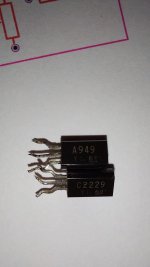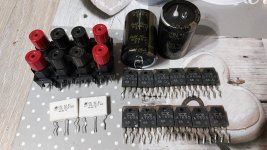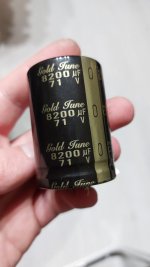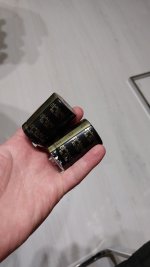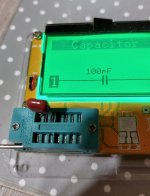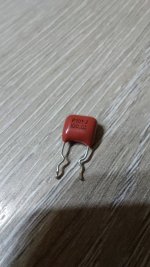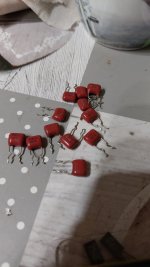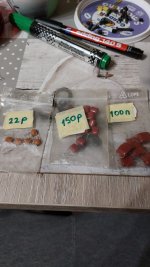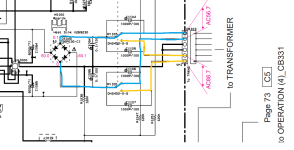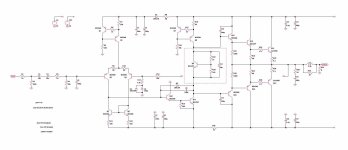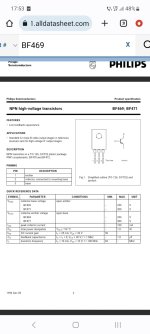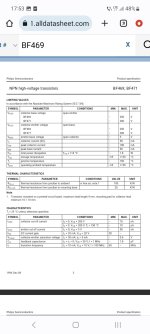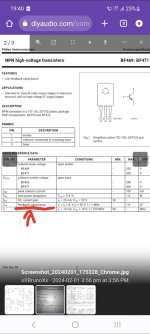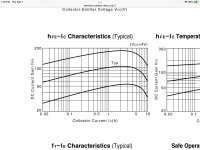Hi, are 2SC2229 / 2SA949 good in audio , for pre drivers / drivers or Vas ?. on low rails like +-35v , better use BD139/140 for higher power?.
- Bruno.
- Bruno.
They look like better VAS transistors than the BD’s, but maybe a bit small for drivers on +/-35. I can see power transistors wanting more than 50 mA of base current (and the gain will drop long before that).
Where did you dig those up?
Where did you dig those up?
@wg_ski So sorry for late reply !. I got some nice speaker terminals, dual 5w 0.22 resistors, some transistors, caps.
Wonder why they did not use ceramic caps for Cdom for example, and used this big ones. 100 - 150 p
Wonder why they did not use ceramic caps for Cdom for example, and used this big ones. 100 - 150 p
Attachments
Nice Sanken transistor set. I dont see delivery dates posted in Digikey for Sankens anymore, not taking backorders, and stock is dwindling. They may be getting hard to get. Definitely hang onto them for a project where they’ll make a difference.
Those do look like film caps instead of MLCC’s. Could sacrifice one to see what’s inside.
Any word on the transformer?
Those do look like film caps instead of MLCC’s. Could sacrifice one to see what’s inside.
Any word on the transformer?
Ok, quite useable. 4/8 ohm switchable, or even H-class (if you can stand the concept).
+/-60 volts is pushing it on one output pair, even for 8 ohms. The 4 ohm switch is certainly needed in the original design. But hey, you’ve got options when you go to build with it.
+/-60 volts is pushing it on one output pair, even for 8 ohms. The 4 ohm switch is certainly needed in the original design. But hey, you’ve got options when you go to build with it.
I have another set of 2sc4468/2sa. , x8 from a class ab car amp , they look the same but better Hfe category.
Currently building this small' amp for my desk speakers. +-35v DC 200w toroid.
I tought using 2sc2229/2sa940 as pre drivers, BD139/140 drivers, 2sc4468/2sa as outputs
Not sure about the Vas, using two 2sc2229 or one 2sc2229 and bd139. Also have some " interesting " ( BF459, BF469, low capacitance, decent speed,)
Small transistors are 2sc1815/2sa1015, LTP, CCS and current mirror.
Vas current source maybe 2sc1815 and bd139 at 10mA .
Currently building this small' amp for my desk speakers. +-35v DC 200w toroid.
I tought using 2sc2229/2sa940 as pre drivers, BD139/140 drivers, 2sc4468/2sa as outputs
Not sure about the Vas, using two 2sc2229 or one 2sc2229 and bd139. Also have some " interesting " ( BF459, BF469, low capacitance, decent speed,)
Small transistors are 2sc1815/2sa1015, LTP, CCS and current mirror.
Vas current source maybe 2sc1815 and bd139 at 10mA .
Attachments
I wouldnt sweat over hFE rank with an EF3. That’s one of the reasons for going that route. Open loop gain gets limited by VAS Early voltage, not output stage gain.
Not sure I really understood what you said.wouldnt sweat over hFE rank with an EF3. That’s one of the reasons for going that route
You mean output transistors hFe category ?
Also, Vas recommendation from what I've listed up ?.
Thanks !.
When the composite hFE of 3 stages gets north of 100,000 it doesn‘t really matter what it is anymore, or even if the + and - halves match. The reflected load impedance isn’t what limits the VAS gain anymore, it is properties intrinsic to it that do. Extended-beta drivers should be used regardless, to ensure that hFE stays above 100k even as it drops in the output transistor(s) at high current. This is one good reason to use BD139/40 if voltages permit it - their hFE stays high under 2V Vce, whereas higher voltage types typically do NOT. On limited supply voltage, this matters.
If you are darlington-ing the VAS, bigger ones can be used - like the BD139. The buffer should have as low a Cob as possible to minimize nonlinear effects. Dont need crazy high hfe there anymore either with 2 stages. But you do want it linear.
If you are darlington-ing the VAS, bigger ones can be used - like the BD139. The buffer should have as low a Cob as possible to minimize nonlinear effects. Dont need crazy high hfe there anymore either with 2 stages. But you do want it linear.
Thank you for your time and explanation.When the composite hFE of 3 stages gets north of 100,000 it doesn‘t really matter what it is anymore, or even if the + and - halves match. The reflected load impedance isn’t what limits the VAS gain anymore, it is properties intrinsic to it that do. Extended-beta drivers should be used regardless, to ensure that hFE stays above 100k even as it drops in the output transistor(s) at high current. This is one good reason to use BD139/40 if voltages permit it - their hFE stays high under 2V Vce, whereas higher voltage types typically do NOT. On limited supply voltage, this matters.
If you are darlington-ing the VAS, bigger ones can be used - like the BD139. The buffer should have as low a Cob as possible to minimize nonlinear effects. Dont need crazy high hfe there anymore either with 2 stages. But you do want it linear.
I've measured Hfe of the 2sc4468/2sa1695.
The PNP's have around 100 and the NPN's around 20 , what the hell is my LCR measuring bad or how can there be such a big difference. They are all P Hfe category.
The PNP's have around 100 and the NPN's around 20 , what the hell is my LCR measuring bad or how can there be such a big difference. They are all P Hfe category.
Measuring at too low a current. The PNP gain profile is flat down into the micro amps, the NPN is not. Sanken’s economy devices are apparently not immune to this low current slope. It can be a lot worse on vintage 3 MHz 2N types. Once biased into optimum range for an EF (26 mV across the resistor, or more heavily as a driver for a big power bank) the hFE variation is no worse than in the upper useable range (5 to 8 amps).
Attachments
- Home
- Design & Build
- Parts
- 2SC2229 / 2SA949
